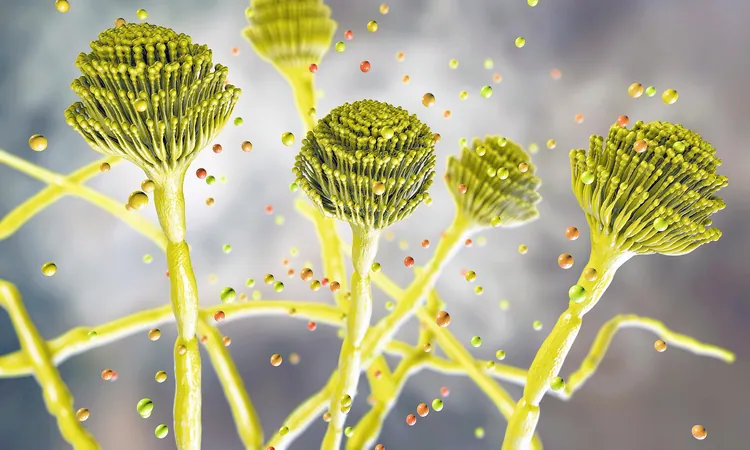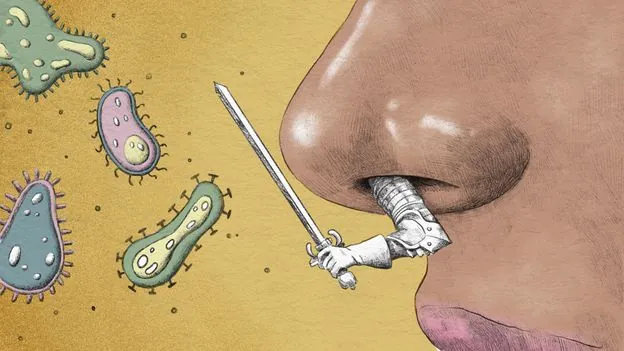
The Silent Danger: Deadly Fungus Now Spreading Across the U.S. and Beyond
2025-06-14
Author: Kai
Every day, we breathe in countless invisible spores, many harmless, but some harbor a sinister threat. Certain fungi have the potential to invade our lungs, devastate crops, and disrupt ecosystems—all at once. Without warning, this rapidly spreading menace can turn from a natural recycler into a lethal invader.
While most fungi play vital roles in our environment, a select few tap into our vulnerabilities, especially when health systems falter and climate challenges rise.
The Aspergillus Problem
Researchers, led by Dr. Norman van Rhijn from The University of Manchester, have closely examined the notorious Aspergillus genus. Three species—A. flavus, A. fumigatus, and A. niger—are of particular concern, especially under climate change scenarios. Their findings forecast a grim future.
In a concerning scenario driven by fossil fuel reliance, researchers predict these fungi will indefinitely spread through Europe, with A. flavus's habitat potentially expanding by 16%, placing over a million people at risk. A. fumigatus, the primary culprit behind serious infections, could threaten an additional nine million people as its territory swells by 77.5%.
Climate Change: A Catalyst for Fungal Spread
Dr. van Rhijn notes that key environmental factors like humidity and temperature shifts significantly influence where these fungi flourish. Some regions may even become inhospitable to certain fungi due to extreme heat, showing the complex regional trade-offs in their survival.
Escalating Health Risks
Forecasting the spread of such pathogens may seem like a distant concern, but we’re already witnessing the fallout. Hospitals across the globe are reporting troubling outbreaks of Aspergillus after construction work and severe dust storms. Patients recovering from illnesses like COVID-19 are particularly susceptible to these infections.
As outdoor spore counts rise, healthcare costs are expected to soar, especially as diagnostic tools for fungal infections lag behind other pathogens.
The Rising Cost of Aspergillus
Farmers are not immune either; the U.S. corn industry alone can suffer over a billion-dollar loss due to a single year of heavy Aspergillus growth. Increased temperatures and humidity allow fungi a longer growing season, forcing farmers to discard or dilute contaminated crops—an economic and health risk.
Resistant to Treatment
The rise of azole-resistant strains of Aspergillus is alarming. Resistance rates in Europe and Asia have surged, leading to mortality rates of over 50% in infected patients due to limited treatment options.
A Call to Action: Prepare for the Future
Aspergillus is not the only microbial villain on the rise; other fungal threats like Fusarium and Cryptococcus are also adapting to our warming world. The World Health Organization has even prioritized Aspergillus and Candida due to their emerging threat status.
To battle these fungal foes, experts advocate for more coordinated efforts in monitoring and research. Enhanced air quality sensors, integrated agricultural sampling, and hospital tracking could help us stay one step ahead.
Addressing climate change and updating fungicide practices are crucial to curbing resistance and safeguarding public health. Without these strategic actions, what remains manageable today could become tomorrow’s silent pandemic. The fight against Aspergillus—and the fungal threats it represents—has only just begun.
Conclusion
With urgent research and collaborative efforts, we can strive to minimize the impact of deadly fungi in our rapidly changing world, ensuring that these ancient decomposers do not morph into unprecedented menaces.




 Brasil (PT)
Brasil (PT)
 Canada (EN)
Canada (EN)
 Chile (ES)
Chile (ES)
 Česko (CS)
Česko (CS)
 대한민국 (KO)
대한민국 (KO)
 España (ES)
España (ES)
 France (FR)
France (FR)
 Hong Kong (EN)
Hong Kong (EN)
 Italia (IT)
Italia (IT)
 日本 (JA)
日本 (JA)
 Magyarország (HU)
Magyarország (HU)
 Norge (NO)
Norge (NO)
 Polska (PL)
Polska (PL)
 Schweiz (DE)
Schweiz (DE)
 Singapore (EN)
Singapore (EN)
 Sverige (SV)
Sverige (SV)
 Suomi (FI)
Suomi (FI)
 Türkiye (TR)
Türkiye (TR)
 الإمارات العربية المتحدة (AR)
الإمارات العربية المتحدة (AR)